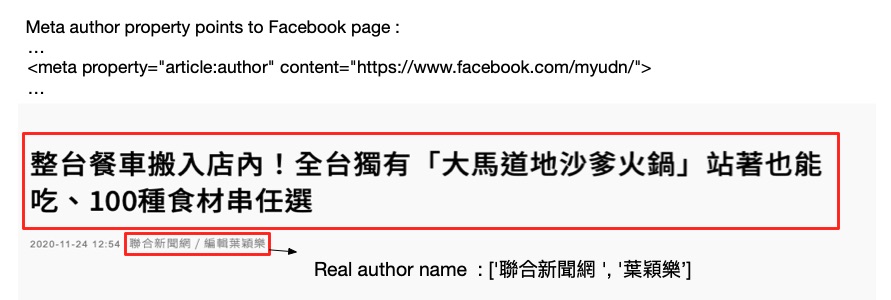Based on the popular content extraction package Dragnet, ExtractNet extend the machine learning approach to extract other attributes such as date, author and keywords from news article.
Example code:
Simply use the following command to install the latest released version:
pip install extractnetStart extract content and other meta data passing the result html to function
import requests
from extractnet import Extractor
raw_html = requests.get('https://currentsapi.services/en/blog/2019/03/27/python-microframework-benchmark/.html').text
results = Extractor().extract(raw_html)We discover some webpage doesn't provide the real author name but simply populate the author tag with a default value.
For example ltn.com.tw, udn.com always populate the same author value for each news article while the real author can only be found within the content.
ExtractNet uses machine learning approach to extract these relevant data through visible section of the webpage just like a human.
-
ExtractNet is a platform to extract any interesting attributes from any webpage, not just limited to content based article.
-
The core of ExtractNet aims to convert unstructured webpage to structured data without relying hand crafted rules
-
ExtractNet do not support boilerplate content extraction
-
ExtractNet allows user to add custom pipelines that returns additional data through a list of callbacks function
Results of the body extraction evaluation:
We use the same body extraction benchmark from article-extraction-benchmark
| Model | Precision | Recall | F1 | Accuracy | Open Source |
|---|---|---|---|---|---|
| AutoExtract | 0.984 ± 0.003 | 0.956 ± 0.010 | 0.970 ± 0.005 | 0.470 ± 0.037 | ✗ |
| Diffbot | 0.958 ± 0.009 | 0.944 ± 0.013 | 0.951 ± 0.010 | 0.348 ± 0.035 | ✗ |
| ExtractNet | 0.922 ± 0.011 | 0.933 ± 0.013 | 0.927 ± 0.010 | 0.160 ± 0.027 | ✔ |
| boilerpipe | 0.850 ± 0.016 | 0.870 ± 0.020 | 0.860 ± 0.016 | 0.006 ± 0.006 | ✔ |
| dragnet | 0.925 ± 0.012 | 0.889 ± 0.018 | 0.907 ± 0.014 | 0.221 ± 0.030 | ✔ |
| html-text | 0.500 ± 0.017 | 0.994 ± 0.001 | 0.665 ± 0.015 | 0.000 ± 0.000 | ✔ |
| newspaper | 0.917 ± 0.013 | 0.906 ± 0.017 | 0.912 ± 0.014 | 0.260 ± 0.032 | ✔ |
| readability | 0.913 ± 0.014 | 0.931 ± 0.015 | 0.922 ± 0.013 | 0.315 ± 0.034 | ✔ |
| trafilatura | 0.930 ± 0.010 | 0.967 ± 0.009 | 0.948 ± 0.008 | 0.243 ± 0.031 | ✔ |
Results of author name extraction:
| Model | F1 |
|---|---|
| ExtractNet : fasttext embeddings + CRF | 0.904 ± 0.10 |
-
Underlying classifier is replaced by Catboost instead of Decision Tree for all attributes extraction for consistency and performance boost.
-
Updated CSS features, added text+css latent feature
-
Includes a CRF model that extract names from author block text.
-
Trained on 22000+ updated webpages collected in the late 2020, 20 times of dragnet data.
pip install extractnet
from extractnet import Extractor
raw_html = requests.get('https://apnews.com/article/6e58b5742b36e3de53298cf73fbfdf48').text
results = Extractor().extract(raw_html)
for key, value in results.items():
print(key)
print(value)
print('------------')ExtractNet also support the ability to add callbacks functions to inject additional features during extraction process
A quick glance of usage : each callbacks will be able to access the raw html string provided during the extraction process. This allows user to extract addtional information such as language detection to the final results
def meta_pre1(raw_html):
return {'first_value': 0}
def meta_pre2(raw_html):
return {'first_value': 1, 'second_value': 2}
def find_stock_ticker(raw_html, results):
matched_ticker = []
for ticket in re.findall(r'[$][A-Za-z][\S]*', str(results['content'])):
matched_ticker.append(ticket)
return {'matched_ticker': matched_ticker}
extract = Extractor(author_prob_threshold=0.1,
meta_postprocess=[meta_pre1, meta_pre2],
postprocess=[find_stock_ticker])The extracted results will contain like, first_value and second_value. Do note callbacks are executed by the given order ( which means meta_pre1 will be executed first followed by meta_pre2 ), any results passed from the previous stage will not be overwritten by later stage
raw_html = requests.get('https://apnews.com/article/6e58b5742b36e3de53298cf73fbfdf48').text
results = extract(raw_html)In this example the value for first_value will remain 0 even though meta_pre2 also returns first_value=1 because meta_pre2 callbacks already assign first_value as 0.
We love contributions! Open an issue, or fork/create a pull request.
Coming soon
[1] Peters, Matthew E. and D. Lecocq, Content extraction using diverse feature sets
@inproceedings{Peters2013ContentEU,
title={Content extraction using diverse feature sets},
author={Matthew E. Peters and D. Lecocq},
booktitle={WWW '13 Companion},
year={2013}
}
[2] A. Joulin, E. Grave, P. Bojanowski, T. Mikolov, Bag of Tricks for Efficient Text Classification
@article{joulin2016bag,
title={Bag of Tricks for Efficient Text Classification},
author={Joulin, Armand and Grave, Edouard and Bojanowski, Piotr and Mikolov, Tomas},
journal={arXiv preprint arXiv:1607.01759},
year={2016}
}

